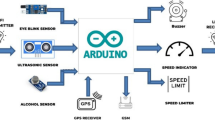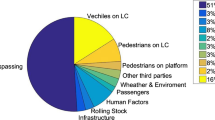Abstract
When large-scale disasters occur, evacuees have to evacuate to safe places quickly. They, however, may not be able to afford to obtain sufficient information for their evacuations under such emergent situations. In this paper, we propose an automatic evacuation guiding scheme using evacuees’ mobile nodes, e.g., smart phones. The key idea to achieve automatic evacuation guiding is implicit interactions between evacuees and their mobile nodes. Each mobile node tries to navigate its evacuee by presenting an evacuation route. At the same time, it can also trace the actual evacuation route of the evacuee as the trajectory by measuring his/her positions periodically. The proposed scheme automatically estimates blocked road segments from the difference between the presented evacuation route and the actual evacuation route, and then recalculates the alternative evacuation route. In addition, evacuees also share such information among them through direct wireless communication with other mobile nodes and that with a server via remaining communication infrastructures. Through simulation experiments, we show that 1) the proposed scheme works well when the degree of damage is high and/or road segments are continuously blocked, 2) the average evacuation time can be improved even in small penetration ratio of the proposed system, and 3) the direct wireless communication can support many evacuations at almost the same level as the communication infrastructure when the number of evacuees becomes large.





Similar content being viewed by others
References
Aschenbruck N, Gerhards-Padilla E, Martini P (2009) Modeling mobility in disaster area scenarios. Perform Eval 66(12):773–790
Chen C, Zhang D, Samuel Castro P, Li N, Sun L, Li S (2012) Real-Time Detection of anomalous taxi trajectories from GPS traces. Lecture notes of the institute for computer sciences. Soc-Informatics Telecommun Eng 104:63–74
Fall K (2003) A Delay-Tolerant network architecture for challenged internets. In: Proc. of SIGCOMM’03, pp 27–34
Fujihara A, Miwa H (2014) Disaster evacuation guidance using opportunistic communication: The potential for Opportunity-Based service. In: bessis N., Dobre C. (eds) Big Data and Internet of Things: A Roadmap for Smart Environments Studies in Computational Intelligence, pp. 425–446. Springer International Publishing
Hashemi M, Karimi HA (2014) A critical review of Real-Time Map-Matching algorithms: Current issues and future directions. Comput Environ Urban Syst 48:153–165
Iizuka Y, Yoshida K, Iizuka K (2011) An effective disaster evacuation assist system utilized by an Ad-Hoc network. In: Proc. of HCI international 2011, pp. 31–35
Inoue M, Ohnishi M, Peng C, Li R, Owada Y (2011) Nervenet: A Regional Platform Network for Context-Aware Services with Sensors and Actuators. IEICE Trans Commun E94-B(3):618–629
Keränen A., Ott J, Kärkkäinen T. (2009) The ONE simulator for DTN protocol evaluation. In: Proc. of the 2nd international conference on simulation tools and techniques, pp 55:1–55:10
Komatsu N, Sasabe M, Kawahara J, Kasahara S (2015) Automatic evacuation guiding scheme using trajectories of mobile nodes. In: Proc. of the 12th international conference on mobile web and intelligent information systems, pp 3–14
Kumar A, Jiang M, Fang Y (2014) Where not to go?: Detecting road hazards using twitter. In: Proc. of the 37th international ACM SIGIR conference on research & development in information retrieval, pp 1223–1226
Lim GJ, Zangeneh S, Baharnemati MR, Assavapokee T (2012) A capacitated network flow optimization approach for short notice evacuation planning. Eur J Oper Res 223(1):234–245
Martín-Campillo A., Crowcroft J, Yoneki E, Martí R. (2013) Evaluating opportunistic networks in disaster scenarios. J Netw Comput Appl 36(2):870–880
Ministry of Internal Affairs and Communications: 2011 WHITE PAPER Information and Communications in Japan. http://www.soumu.go.jp/johotsusintokei/whitepaper/eng/WP2011/2011-index.html
Samadzadegan F, Zarrinpanjeh N (2008) Earthquake destruction assessment of urban roads network using satellite imagery and fuzzy inference systems. The international archives of the photogrammetry. Remote Sens Spat Inf Sci 37(B8):409–414
Sugiman T, Misumi J (1988) Development of a new evacuation method for emergencies: Control of collective behavior by emergent small groups. J Appl Psychol 73(1):3–10
Takizawa A, Takechi Y, Ohta A, Katoh N, Inoue T, Horiyama T, Kawahara J, Minato S (2013) Enumeration of region partitioning for evacuation planning based on ZDD. In: Proc. of of the international symposium on operations research and its applications, pp 64–71
Uddin MYS, Nicol DM, Abdelzaher TF, Kravets RH (2009) A Post-Disaster mobility model for delay tolerant networking. In: Proc. of the 2009 winter simulation conference, pp 2785–2796
Vahdat A, Becker D (2000) Epidemic routing for partially connected ad hoc networks. Tech. Rep. CS-200006 duke university
Winter S, Richter K, Shi M, Gan H (2011) Get me out of here: Collaborative evacuation based on local knowledge. In: Proc. of third international workshop on indoor spatial awareness, pp 35–42
Author information
Authors and Affiliations
Corresponding author
Additional information
This paper is an expanded version of the paper presented at The 12th International Conference on Mobile Web and Intelligent Information Systems (MobiWis 2015) [9] . This research was partly supported by Strategic Information and Communication R&D Promotion Programme (SCOPE) of Ministry of Internal Affairs and Communications, and JSPS KAKENHI Grant Number 15H04008, Japan.
Rights and permissions
About this article
Cite this article
Komatsu, N., Sasabe, M., Kawahara, J. et al. Automatic evacuation guiding scheme based on implicit interactions between evacuees and their mobile nodes. Geoinformatica 22, 127–141 (2018). https://doi.org/10.1007/s10707-016-0270-1
Received:
Revised:
Accepted:
Published:
Issue Date:
DOI: https://doi.org/10.1007/s10707-016-0270-1




